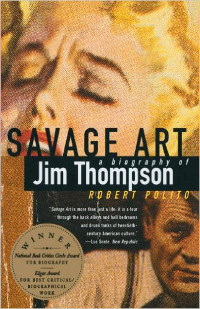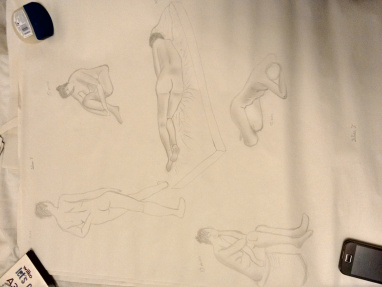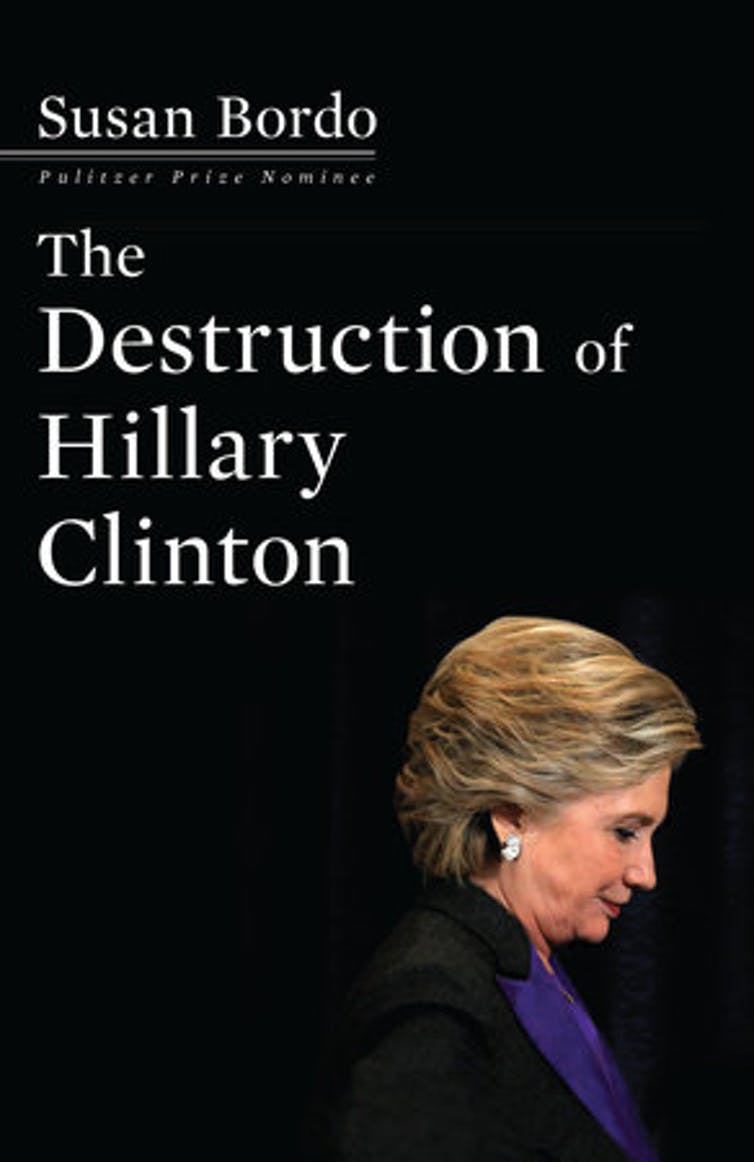 Savage Art by Robert Polito is a literary biography of pulp crime novelist Jim Thompson. At more than 500 pages, it’s an impressively detailed and comprehensive book, with in-depth coverage of all of Thompson’s novels.
Savage Art by Robert Polito is a literary biography of pulp crime novelist Jim Thompson. At more than 500 pages, it’s an impressively detailed and comprehensive book, with in-depth coverage of all of Thompson’s novels.
Thompson led a hard-drinking life, bouncing from various jobs until he achieved success in pulp crime novels in the Fifties and Sixties. In the Seventies, after suffering several strokes, Thompson could no longer write and none of his books remained in print. Despite these setbacks, he boasted to his wife, “Just you wait, I’ll be famous after I’m dead about ten years.” Hastening the end, he stopped eating, and several days later he died on April 7, 1977.
A prophetic remark. In 1990, the critically-acclaimed movie The Grifters appeared, followed by movie versions of After Dark, My Sweet, The Kill-Off, The Frightening Frammis (directed by Tom Cruise!), and a remake of The Getaway starring Alec Baldwin and Kim Basinger. Slightly more than ten years after his death, Thompson was red hot, and his books were back in print.
Thompson was born in Anadarko, Oklahoma Territory, in 1906. He published his first novel, Now And On Earth, in 1942 at the age of 36. Today he is known primarily as a crime writer. Most of his novels were written in a stunning 18-month burst of productivity between 1952 and 1954, when he churned out 12 paperback originals for Lion Books, a pulp publisher that also published the work of David Goodis, Robert Bloch, and Richard Matheson. Lion Books couldn’t even keep up with Thompson’s output, and several of Thompson’s best novels come from that prolific period.
After Lion went out of business, Thompson got involved with up-and-coming director Stanley Kubrick, with whom he wrote the screenplay for the noir classic The Killing. Unfortunately, Kubrick denied Thompson screenwriting credit, giving him a “dialogue by” credit instead. Surprisingly, Thompson partnered with Kubrick again on Paths of Glory, sharing credit with two other writers.
The sad figure that hangs over much of Thomson’s novels is his father, Big Jim Thompson, a corrupt sheriff in the Oklahoma Territory. The violence and child abuse prevalent in Thompson’s novels was obviously based on personal experience, and his Oedipal rivalry with his smooth-talking father manifests itself in Thompson’s two fictional sheriffs, Lou Ford in The Killer Inside Me and Nick Corey in Pop. 1280.
Through the course of this long biography, Polito highlights the many ups and downs of Thompson’s career. He did historical writing for the WPA, magazine and newspaper writing, true crime, pulp fiction, movie and TV scripts, and novelizations. His later years were marked by ill health due to alcoholism, ulcers, and several strokes. For long periods, he lived apart from his family to work different jobs. In his final years, he was preyed upon by Hollywood producers who took advantage of him.
If you’re interested in Thompson’s work, Polito’s book is the best place to go. I doubt there will ever be a better, more comprehensive biography of Thompson. Although the early parts of the book on Thompson’s Oklahoma years are slow-going, the center of the book, which details Thompson’s most productive period, is fascinating. Polito, a true scholar of noir, quotes extensively from Thompson’s novels, and provides incisive summaries and critical analyses of them. After reading the book, you may feel like you know the novels so well you won’t need to read them.
Thompson’s novels are all short, simply plotted, and feature only a handful of flawed, low-life characters (grifters, prostitutes, alcoholics, con-men, ex-cons, psychos, and corrupt sheriffs) who generally exhibit only basic emotions, such as contempt, Jealousy, greed, lust, and desperation. His books usually offer lurid twists, absurd flourishes, and surreal, nihilistic endings. Dialogue was Thompson’s strong suit, making his slim novels realistic and lively.
Savage Art
Robert Polito
Vintage
Here are some of Thompson’s best novels:
The Killer Inside Me (1952)Perhaps Thompson’s most famous novel, it also features his most memorable character, Lou Ford, a psychopathic sheriff in a small Texas town. The first-person narration is fascinating, offering a frightening glimpse into a deranged mind. Hollywood has tried to adapt this story twice, both times unsuccessfully.
Savage Night (1953)One of the strangest, most depraved pulp crime novels of the Fifties. It reads like a script for a surreal David Lynch movie. It concerns an infamous 35-year-old, baby-faced, five-foot tall, tubercular hit man Charlie “Little” Bigger (a.k.a. Carl Bigelow), who is hired by “The Man” to kill Jake Winroy, a bookie scheduled to testify in an upcoming mob trial in Peardale, Long Island. Despite Charlie’s odd appearance—he wears elevator shoes, contacts, and false teeth—he’s soon involved in a love triangle with Fay, Jake’s lusty wife, and Ruthie, their one-legged housekeeper. The book has a macabre ending right out of a Stephen King novel.
After Dark, My Sweet (1955)A simple, straightforward thriller about a kidnapping. Escaped mental patient and ex-boxer Kid Collins gets involved with a crooked ex-cop named Uncle Bud and a drunken floozy named Fay, who enlist him in the kidnapping of a boy. To complicate things, the boy turns out to be diabetic. Again, the first-person narration by Collins sets the book apart. The 1990 movie version directed by James Foley is very good.
The Getaway (1958)A dark crime thriller about professional bank robbers on the run after a daring bank robbery. After the heist, Doc McCoy shoots his accomplice Rudy Torrento and mistakes him for dead, setting up the book’s suspenseful chase plot. The violence in the book is unrelenting; I lost count of the killings. The book is weak on character, but Thompson handles the book’s dual narrative expertly, guiding it to an exciting confrontation. But the book doesn’t end there. In the final third of the book, McCoy and his wife Carol head for the criminal sanctuary of legendary crime lord “El Rey” (the king) in Mexico, where they find a disturbing vision of hell. The two movie adaptations understandably depart from the book’s downbeat, surreal ending.
The Grifters (1963)A tightly-plotted incestuous triangle about three grifters, or con artists: Roy Dillon, a small-time grifter who hides his stash of money behind his clown painting; Lillie Dillon, Roy’s mom, a hardened racetrack collector for the mob; and Moira Langtry, a hustler who’s also pulled off big cons. Thompson throws these characters together and manipulates them expertly, right up to the shocking conclusion. The 1990 movie version directed by Stephen Frears and written by Donald E. Westlake is widely acknowledged to be the best Thompson adaptation.
Pop 1280 (1964)Another book about a psychopathic Texas sheriff, but this one’s a hoot. It’s at turns hilarious and horrific. The dramatic shifts in tone make the book continuously surprising, all due to the unreliable narrator, Nick Corey, a lazy, amoral, womanizing sheriff of Potts County, Texas, between the wars. To avoid trouble (and work) Corey plays dumb and speaks like an ignorant yokel, but he’s more clever than he seems, and he quietly schemes against everyone who’s humiliated him, including his unfaithful wife. In shocking bursts of violence, he murders without compunction, and he manipulates others to murder for him. Lou Ford may be Thompson’s most famous character, but Nick Corey is his funniest and most cynical creation. The book is also a razor-sharp satire on the hypocrisy, racism, and bigotry of small-town America. The French movie Coup de Torchon (1981), directed by Bertrand Tavernier, is adapted from the book, but its location was shifted from Texas to French West Africa (now Senegal).
Share this:




